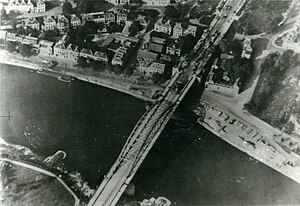
Back معركة آرنم Arabic Arnem döyüşü Azerbaijani آرنهم دؤیوشو AZB Schlacht um Arnheim German Μάχη του Άρνεμ Greek Batalo de Arnhemo Esperanto Batalla de Arnhem Spanish نبرد آرنم Persian Bataille d'Arnhem French Slach om Arnhim Frisian
| Battle of Arnhem | |||||||
|---|---|---|---|---|---|---|---|
| Part of Operation Market Garden | |||||||
 Aerial reconnaissance photo of the Arnhem road bridge taken by the Royal Air Force on 19 September, showing signs of the British defence on the northern ramp and wrecked German vehicles from the previous day's fighting. | |||||||
| |||||||
| Belligerents | |||||||
|
|
| ||||||
| Commanders and leaders | |||||||
|
|
| ||||||
| Strength | |||||||
|
1 reinforced airborne division 1 parachute infantry brigade RAF supply flights Limited support from XXX Corps in later stages |
Initially equivalent to: 1 Kampfgruppe 1 armoured division* | ||||||
| Casualties and losses | |||||||
|
Approx 1,984 killed 6,854 captured** |
Approx 1,300 killed 2,000 wounded** | ||||||
|
*More details of the German strengths can be found in the German forces section **More detailed information is available in the losses sections | |||||||
The Battle of Arnhem was fought during the Second World War,as part of the Allied Operation Market Garden. It took place around the Dutch city of Arnhem and vicinity from 17 to 26 September 1944. The Allies had swept through France and Belgium in August 1944, after the Battle of Normandy. Market Garden was proposed by Field Marshal Sir Bernard Montgomery, who favoured a single push northwards over the branches of the Lower Rhine River, allowing the British Second Army to bypass the Siegfried Line and attack the important Ruhr industrial area.
The First Allied Airborne Army was to capture the bridges to secure a route for the Second Army with US, British and Polish airborne troops dropped in the Netherlands along the line of the ground advance, being relieved by the British XXX Corps. Farthest north, the British 1st Airborne Division landed at Arnhem to capture bridges across the Nederrijn (Lower Rhine), with the 1st Polish Parachute Brigade following on. XXX Corps was expected to reach Arnhem in two to three days.
The 1st Airborne Division landed some distance from its objectives and met unexpected resistance, especially from elements of the II SS Panzer Korps. Only a small force was able to reach the Arnhem road bridge while the main body of the division was stopped on the edge of town. XXX Corps's advance north from Nijmegen was delayed due to the failure, in the Battle of Nijmegen, to secure the bridge before the ground troops arrived and the British were not relieved on time. After four days, the small British force at the bridge was overwhelmed and the rest of the division was trapped in a small pocket north of the river.
The paratroops could not be sufficiently reinforced by the Poles or by XXX Corps when they arrived on the southern bank, nor by Royal Air Force supply flights. After nine days of fighting, the remnants of the division were withdrawn in Operation Berlin. The Allies were unable to advance further and the front line stabilised south of Arnhem. The 1st Airborne Division lost nearly three quarters of its strength and did not see combat again.
© MMXXIII Rich X Search. We shall prevail. All rights reserved. Rich X Search